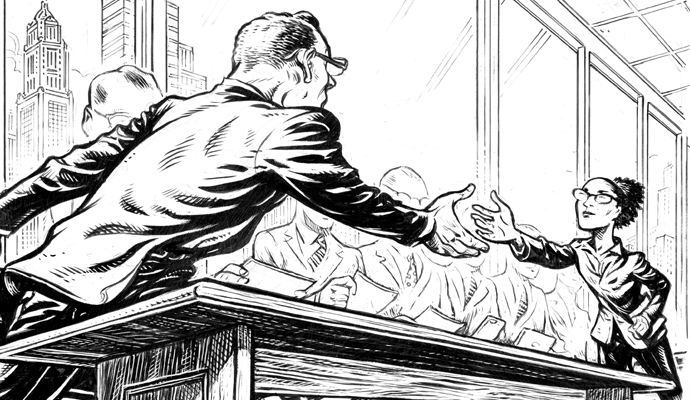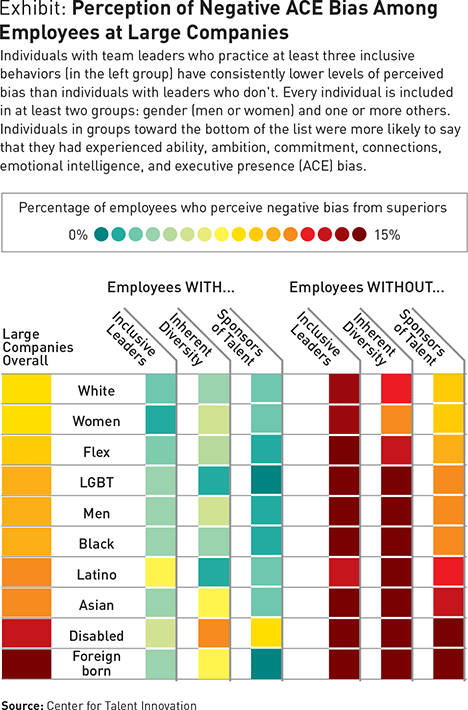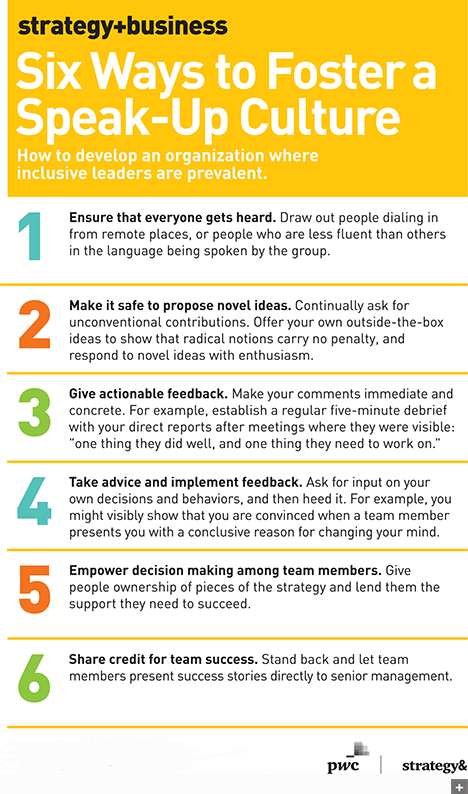How to Keep Perceived Bias from Holding Back High-Potential Employees
When talented people from diverse backgrounds fail to rise in a company, there are three powerful solutions: having more inclusive team leaders, more diversity among the top leadership, and better sponsorship practices.
A version of this article appeared in the Winter 2017 issue of strategy+business.
“I’m just disgusted,” said Angela (not her real name), a vice president at a major financial-services firm. “The company can keep doing things the wrong way. It’s not my problem.”
That is the last thing that leaders of most businesses want to hear. And Angela herself, an African-American woman who originally had been fast-tracked as a high-potential employee, was not happy that she felt this way. But it was grounded in a sober realization: She was receiving consistent signals that even though she believed in her own potential to rise higher in the enterprise, her superiors didn’t.
The year before, Angela had identified a significant flaw in the way her company was analyzing a risk-related metric. She brought it to her boss’s attention only to be ignored. So she convened a small group of more experienced executives at the firm, who all happened to be older white men, to review her analysis. This group reached the same conclusions she had. The result would enable the firm to dial down risk exposure that it hadn’t known it had.
9.2 percent of white-collar employees at large companies perceived that they were underrated.
Angela expected that her superiors would congratulate her for her analysis, her persistence in raising awareness of it, and her ability to bring together a group inside the company to confirm it. She hoped that her superiors might let her present her findings to senior management. Instead, they merely thanked her for thinking to put together the group. They asked a white man on Angela’s team who was junior to her to write up their findings. His report repeated, word for word, Angela’s insight of the month before, but didn’t mention her. Her superiors lavishly praised him for his good work and invited him to present his report to senior management. His career was now launched. Angela’s remained stuck in place.
“I’m used to being mistaken for a secretary,” Angela says. “Or if a superior had taken credit for my work, that’s maybe normal too. But this was too much. I’m now just going through the motions here until I get the right offer someplace else. They’re not exactly grooming me to rise any further here. As far as I can see, they never do that for black people.”
Many people feel that their potential is misjudged at some point in their careers. Like Angela, they may see someone else get opportunities and support that they believe they deserve. But how widespread is this experience of career diminishment? Does it happen more often to members of particular groups? And does this perceived bias then undermine the performance of the organization as a whole?
At the Center for Talent Innovation, our research often focuses on questions like these. Thus, in early 2017, we conducted a survey of 3,570 full-time, college-educated employees in white-collar jobs in the United States. The results suggest that Angela isn’t alone in feeling misjudged. We found that 9.2 percent of white-collar workers at large companies (defined as having more than 1,000 employees) perceived that they were underrated in assessments of their potential by their bosses. The proportion of people perceiving this type of bias varied widely, sometimes rising above 20 percent, and other times falling to zero, depending on the company and the individual. The problem is indeed more acute among members of specific groups. Employees with disabilities, people of color, and those born outside the U.S. seemed to be affected most often. And the resulting loss of their commitment and enthusiasm can lead to major costs for the enterprise.
Misjudgments of employee potential that are grounded in deeply held attitudes and biases may seem to be an intractable problem in many organizations. But in CTI’s ongoing studies of employee perceptions of bias, we have identified three factors that can be implemented in just about any company, and that appear to make an enormous difference in supporting talent of all backgrounds. These factors are having more inclusive team leaders (fostering a culture in which people feel free to speak and feel confident of being heard); diversity in the leadership (that is, more people from different backgrounds in top positions); and the sponsorship of diverse people by senior executives. This most recent survey confirmed the power of these three solutions to the perceived-bias problem. With these factors in mind, leaders can do a great deal to change employees’ perception that there’s a bias against them.
The Perception of Bias
To measure the kind of misjudgment that Angela perceived, we asked survey respondents to assess their own potential along the following lines: ability, ambition, commitment, connections, emotional intelligence, and executive presence. Because of the letters these attributes start with, we call it the “ACE” model. We also asked respondents what feedback they’ve received — or how they believe their current superiors judge them — on the same ACE model. Then we compared the two.
When respondents (using the ACE model) rated their own potential highly but perceived that their superiors rated them poorly, we included them in the group who believed themselves unfairly judged. For example, if you say that you’re dedicated to your work but that your supervisors don’t see it, then you believe that your commitment is incorrectly judged.
Potential, unlike performance, is an inherently subjective measure. How can you prove beyond a doubt to your superiors that they should consider and groom you for the leadership role that you think you deserve? Your superiors must be willing to see in you the capacity and potential you see in yourself. When there is a gap in judgment between you and your superior, this comes across as bias, and you are more likely to withdraw your effort and commitment in ways that impose costs on your employer.
By comparing responses from various individuals with different backgrounds, we can gain significant insight into this judgment gap. In this case, we narrowed our data to the 1,918 respondents who worked at large companies and put the results into a heat map (see exhibit). The map shows what percentage of members of different groups perceived being underrated in the six ACE assessment categories.
Some respondents perceived bias in two or more of the ACE categories, a phenomenon that we call “ACE bias.” ACE bias correlates with several potentially costly impacts on employee morale, retention, and performance. Compared with peers who don’t perceive bias, employees at large companies who report ACE bias are more than four times as likely (33 percent versus 8 percent) to regularly feel alienated at work, 3.1 times as likely (31 percent versus 10 percent) to intend to leave their company within a year, and 2.6 times as likely (34 percent versus 13 percent)to have withheld ideas or solutions over the previous six months.
“I’m a natural relationship builder,” an African-American account manager at an advertising firm told us. “If I could be myself a little more, I could contribute more to the company. But to fit in, there’s a lot of myself that I have to keep under wraps. I’m preoccupied with how I’m presenting myself, all day, every day. It’s exhausting.” A Latino portfolio manager at an industrial conglomerate told us, “If I hear of an opening in a firm with the right culture, I’ll try for it, even if the compensation is less than what I’m getting now.” He continued, “What I want is a place that will recognize my work and give me a fair chance to move up.”
Building an Inclusive Culture
How can leaders increase the odds that their organization will be perceived as giving all employees a fair assessment, without distortion from bias? To find answers, we looked at our three possible solutions, and their effects on the percentage of employees who perceive ACE bias. In other words, we tested three behaviors or structures that might “cool down” the heat map.
The first solution was to develop an organization where inclusive leaders are prevalent. In prior research at CTI, we defined inclusive leaders as those who create a “speak-up culture” where members of their teams feel welcome and included, free to share their ideas and opinions, and confident that their ideas are heard and recognized. Leaders, we found, can foster a speak-up culture through the following behaviors:
• Ensure that everyone gets heard. Find ways to draw out people dialing in from remote places or people who are less fluent than others in the language being spoken by the group. You can assign each member a speaking role ahead of time, or actively discourage participants from interrupting hesitant speakers or talking over those with quieter voices.
• Make it safe to propose novel ideas. Continually ask for unconventional contributions. Offer your own outside-the-box ideas to show that radical notions carry no penalty, and respond to novel ideas with enthusiasm.
• Give actionable feedback. Make your comments immediate and concrete. For example, establish a regular five-minute debrief with your direct reports after meetings where they were visible: “one thing you did well; one thing you need to work on.”
• Take advice and implement feedback. Ask for input on your own decisions and behaviors, and then heed it. For example, you might visibly show that you are convinced when a team member presents you with a conclusive reason for changing your mind.
• Empower decision making among team members. Give people ownership of pieces of the strategy and lend them the support they need to succeed.
• Share credit for team success. Stand back and let team members present success stories directly to senior management.
The rates of employees at large companies who perceived ACE bias plunged when they had inclusive leaders. Employees at large companies were 87 percent less likely to perceive ACE bias when they had an inclusive leader. They were also 39 percent more likely than those without an inclusive leader to say that they were engaged at work.
The second solution is having a wider range of diversity among top leaders. The survey asked respondents about gender, race, sexual orientation, and five other lines of difference in company leadership. Employees at large companies with high levels of diversity in their leadership (with at least three lines of difference represented) were 64 percent less likely to perceive ACE bias than those with low levels. Notably, every employee category — including that of white people — was less likely to perceive ACE bias when leadership was diverse.
The third solution, sponsorship of diverse talent, had the most dramatic impact on perceived ACE bias: Individuals at large companies with a reported sponsor (a senior-level advocate willing to use his or her power and influence to help advance the career of a protégé) were 90 percent less likely than those without to perceive ACE bias. Moreover, with sponsors, the risk of foreign-born talent, LGBT employees, and African-Americans at large corporations perceiving ACE bias dropped to nearly zero.
“To move up, it’s so important for senior management to know who you are and know what you’re doing long before the promotion decision is made,” an Afro-Latina client relationship vice president at an entertainment conglomerate told us. “That’s an area where a sponsor can make a big difference, but in my company you almost never see women or people of color having a sponsor.” Data backs up this anecdote: Prior CTI research found that white employees are 63 percent more likely than people of color to have a sponsor.
An Asian-American pharmaceutical executive reported a similar experience: “A while back, I had a manager who was out to get me. She’d never let me take on any kind of responsibilities. Then I got a sponsor, who got to know me and took a leap of faith on me. She arranged for me to get a new position, even though I didn’t check every box that an HR computer might have generated for an ideal candidate. That relaunched my career. I’ve had two promotions since then.”
Taking the Next Steps
Our data suggests some solutions to the bias that appears to persist in corporate America. Your organization can also perform its own diagnostics. Mapping where bias is perceived inside your ranks will make it easier to target, prioritize, and assess interventions. You can then assess an intervention’s efficacy by repeating the diagnostic later to see how your employees’ perception of bias has changed. This new diagnostic will indicate where additional efforts are needed.
The heat map research shown here identifies and quantifies bias where it strikes individuals and organizations most: in the experiences of employees. Heat mapping takes a different tack from the unconscious bias trainings that are currently popular but that lack evidence of effectiveness and may even make bias worse through the implication that managers are to blame. It may be easier to enlist managers as allies if you focus on the perception of bias and on the cost it brings to the organization.
Bias and inequity can’t be eliminated. But by training and encouraging managers in specific inclusive behaviors, working to increase diversity in leadership, and offering sponsorship opportunities to a wider range of people, your company can take measurable steps toward disrupting the experience of bias and reducing its costs. You can then reap the gains of a more motivated workforce and signal to incoming talent that no matter who they are, they won’t be held back because of the groups to which they belong.
Reprint No. 17405
Author profiles:
- Sylvia Ann Hewlett is an economist and the founding president and CEO of the Center for Talent Innovation, a global research and advocacy organization focused on talent and inclusiveness, based in New York. Her books include Executive Presence: The Missing Link between Merit and Success (HarperBusiness, 2014).
- Ripa Rashid is executive vice president at the Center for Talent Innovation, specializing in global talent strategies. She is the coauthor, with Sylvia Ann Hewlett, of Winning the War for Talent in Emerging Markets: Why Women Are the Solution (Harvard Business Press, 2011).
- Laura Sherbin is the chief financial officer and head of research at the Center for Talent Innovation. She is an economist specializing in work–life issues and gender and the coauthor, with Sylvia Ann Hewlett, of Athena 2.0: Accelerating Female Talent in Science, Engineering & Technology (CTI, 2014).







